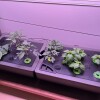Q: This past spring, we tried starting some of our own plants from seed indoors, but they got tall, spindly and weak by the time we wanted to plant them outdoors. What did we do wrong? — Tyler P.
A: Seedlings growing tall and spindly indoors is an age-old problem, and the same wisdom holds true now that it did years ago. The problem occurs if plants are started too early and the light level isn’t intense enough.
ADVERTISEMENT
Because plants grow at different rates, some types need to be started very early, while others should wait until April for seeding indoors. Begonias and onions require many weeks to grow and can be seeded in February. March 1 is the recommended date for seeding petunias, impatiens, coleus and snapdragons. March 15 is the date to seed peppers, cabbage, broccoli and cauliflower. Tomatoes and marigolds should wait until April 1, and zinnias until April 15.
If seeds are started earlier than their recommended date, plants can languish indoors, becoming lanky and weak. In addition, seedlings need high light levels to remain stocky and strong. Plants grown with too little light often stretch and become weak-stemmed.
Seedlings can be grown in a sunny window, but many windows don’t receive full, all-day sunshine as the sun moves across the sky, unless the windows are very wide. The short days of winter and early spring also keep light levels lower than seedlings prefer.
A perfect way to provide seedlings with optimal light is with artificial lights, which can be standard LEDs, fluorescent, or special plant-type lights. Tube-type bulbs distribute light over seedling trays better than round bulbs.
Seedling trays should be kept within several inches of the bulbs. Lights can be set on a timer with 16 hours on and eight hours off, similar to humans getting the recommended eight hours of sleep, which is how I remember it.
Q: Thanks for the recent article on Blue By You salvia. Do you know where we can purchase this perennial come spring? — Rachelle S.
A: Blue By You perennial salvia, an All-America Selections award winner and an outstanding feature in our perennial beds and landscapes, has been on the market for about two years, which is relatively recent as new plants go.
ADVERTISEMENT
As with many new cultivars, it takes time for new plant material to be widely available. Your best bet is to contact locally owned garden centers and inquire, which can be done now. This can give garden centers the opportunity to order the plants if they haven’t already.
With the tens of thousands of plant cultivars available, no garden center can stock them all, but if they receive requests for specific types, they can often add them to their selection. Garden centers plan their inventory far in advance of the spring season, so the earlier a request is made, the more likely it can be fulfilled.
Q: I know you prefer starting cuttings, such as houseplants, in mixtures of vermiculite, sand or potting mix instead of water. I’m curious why that is. Sometimes I have luck in water, but sometimes the cuttings rot. — Jenny S.
A: Some plant types, such as pothos, root very easily in water and can even grow in water for many weeks. Other cutting types rot easily in water, which is why a solid-type medium often works best for coaxing cuttings to root. Sometimes I use high-quality potting mix, other times vermiculite, perlite or sand, and sometimes mixtures.
Besides being less prone to rotting, starting cuttings in a solid-type medium has another important advantage. Roots that form in water are accustomed to growing in water, and when the cuttings are transferred into potting mix, there can be a stressful period of adjustment and shock.
When roots begin forming in solid media, they are often more fibrous, well-branched and less gangly. Because they’re accustomed to growing in a solid medium, there’s usually less transplant shock when transferred into potting mix.
For easy-to-root plants, rooting in water is handy, but solid media has distinct advantages.
ADVERTISEMENT
If you have a gardening or lawn care question, email Don Kinzler, NDSU Extension-Cass County, at donald.kinzler@ndsu.edu . Questions with broad appeal may be published, so please include your name, city and state for appropriate advice.













